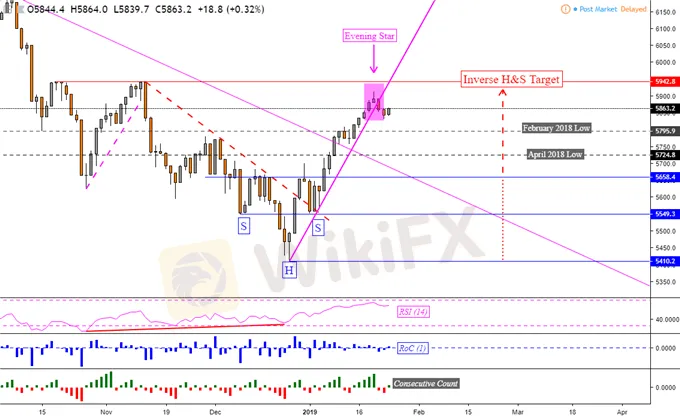简体中文
繁體中文
English
Pусский
日本語
ภาษาไทย
Tiếng Việt
Bahasa Indonesia
Español
हिन्दी
Filippiiniläinen
Français
Deutsch
Português
Türkçe
한국어
العربية
Asia Stocks Rise, AUD Diverges. USD May Rise on ECB as NZD Falls
Abstract:Excluding the Nikkei 225, most Asia Pacific stocks rose. Pro-risk AUD/USD fell despite a rosy jobs report. The ECB may sink the Euro to the
Thursdays Asia Pacific trading session saw a divergence between foreign exchange markets and stocks. Generally, most benchmark stock indexes traded higher excluding the Nikkei 225. Although there were a couple of moments when most fell in tandem. Investors may be wary of the uncertainties facing global growth ahead such as US China trade negotiations and a partial government shutdown in the United States.
Japan‘s Nikkei 225 traded about 0.16% lower heading into the close. The index may be on the verge of a bearish reversal in the near future. Meanwhile China’s Shanghai Composite and South Korea‘s KOSPI climbed roughly 0.50%. Australia’s ASX 200 rose about 0.38%, though local front-end government bond yields aimed lower.
This may have been due to actions from the National Bank of Australia (NAB) to raise rates on variable home loans. For the RBA, this could lessen the urgency to hike in the near-term and this may have been why the Australian Dollar relinquished all of its gains earlier on a rosy domestic jobs report. The pro-risk New Zealand Dollar also declined as the US Dollar saw some strength.
While most Asia stocks traded higher, S&P 500 futures are pointing lower hinting that market mood may turn sour during the US and European trading sessions. The ECB monetary policy announcement is due to cross the wires. Given that President Mario Draghi has highlighted the need for a significant amount of stimulus still, we may see that tone echoed in the statement later today.
This may weaken the Euro and boost the US Dollar, sending it higher against its Australian and New Zealand counterparts. But, declines in AUD/USD and NZD/USD could be somewhat mitigated if stocks rally on a more cautious ECB.
ASX 200 Technical Analysi
Since highlighting the inverse head and shoulders bullish reversal pattern in the ASX 200, prices rose about 1.5%. But, a warning sign has emerged that its next leg could be lower. This is an evening star that formed at its most recent peak just under resistance at 5,942 (the target of the inverse head and shoulders). Prices are now attempting to push higher and more closes to the upside may invalidate the evening star. Near-term support is at 5,795 which is the February 2018 low.
ASX 200 Daily Chart

Disclaimer:
The views in this article only represent the author's personal views, and do not constitute investment advice on this platform. This platform does not guarantee the accuracy, completeness and timeliness of the information in the article, and will not be liable for any loss caused by the use of or reliance on the information in the article.
Read more

KVB Market Analysis | 28 August: Yen Strengthens on BoJ Rate Hike Hints; USD/JPY Faces Uncertainty
The Japanese Yen rose 0.7% against the US Dollar after BoJ Governor Kazuo Ueda hinted at potential rate hikes. This coincided with a recovery in Asian markets, aided by stronger Chinese stocks. With the July FOMC minutes already pointing to a September rate cut, the US Dollar might edge higher into the weekend.

KVB Market Analysis | 27 August: AUD/USD Holds Below Seven-Month High Amid Divergent Central Bank Policies
The Australian Dollar (AUD) traded sideways against the US Dollar (USD) on Tuesday, staying just below the seven-month high of 0.6798 reached on Monday. The downside for the AUD/USD pair is expected to be limited due to differing policy outlooks between the Reserve Bank of Australia (RBA) and the US Federal Reserve. The RBA Minutes indicated that a rate cut is unlikely soon, and Governor Michele Bullock affirmed the central bank's readiness to raise rates again if necessary to combat inflation.

KVB Market Analysis | 23 August: JPY Gains Ground Against USD as BoJ Signals Possible Rate Hike
JPY strengthened against the USD, pushing USD/JPY near 145.00, driven by strong inflation data and BoJ rate hike expectations. Japan's strong Q2 GDP growth added support. However, USD gains may be limited by expectations of a Fed rate cut in September.

KVB Market Analysis | 22 August: Gold Stays Strong Above $2,500 as Fed Rate Cut Hints Loom
Gold prices remain above $2,500, near record highs, as investors await the Federal Open Market Committee minutes for confirmation of a potential Fed rate cut in September. The Fed's dovish shift, prioritizing employment over inflation, has weakened the US Dollar, boosting gold. A recent revision showing the US created 818,000 fewer jobs than initially reported also strengthens the case for a rate cut.
WikiFX Broker
Latest News
eXch Exchange to Shut Down on May 1 Following Laundering Allegations
How a Viral TikTok Scam Cost a Retiree Over RM300,000
JT Capital Markets Review
FCA Proposes Simplifying Investment Cost Disclosure for Retail Investors
Fresh Look, Same Trust – INGOT Brokers Rebrands its Website
FCA Issues Alerts Against Unauthorised and Clone Firms in the UK
Consob Orders Blackout of 9 Fraudulent Financial Websites
Tradu Joins TradingView for Seamless CFD and Forex Trading
Japan Issues Urgent Warning on $700M Unauthorized Trades
Silver surges past $33—are you ready for what comes next?
Currency Calculator


